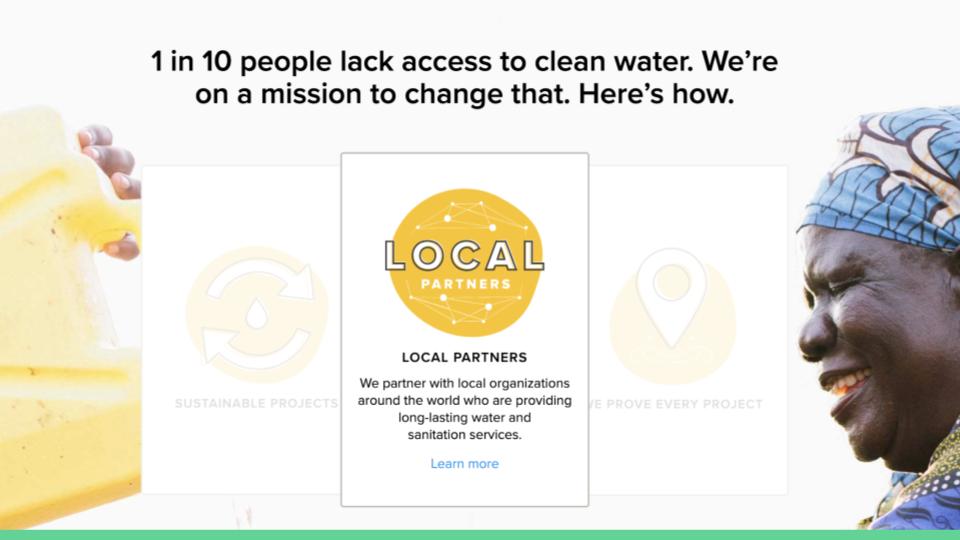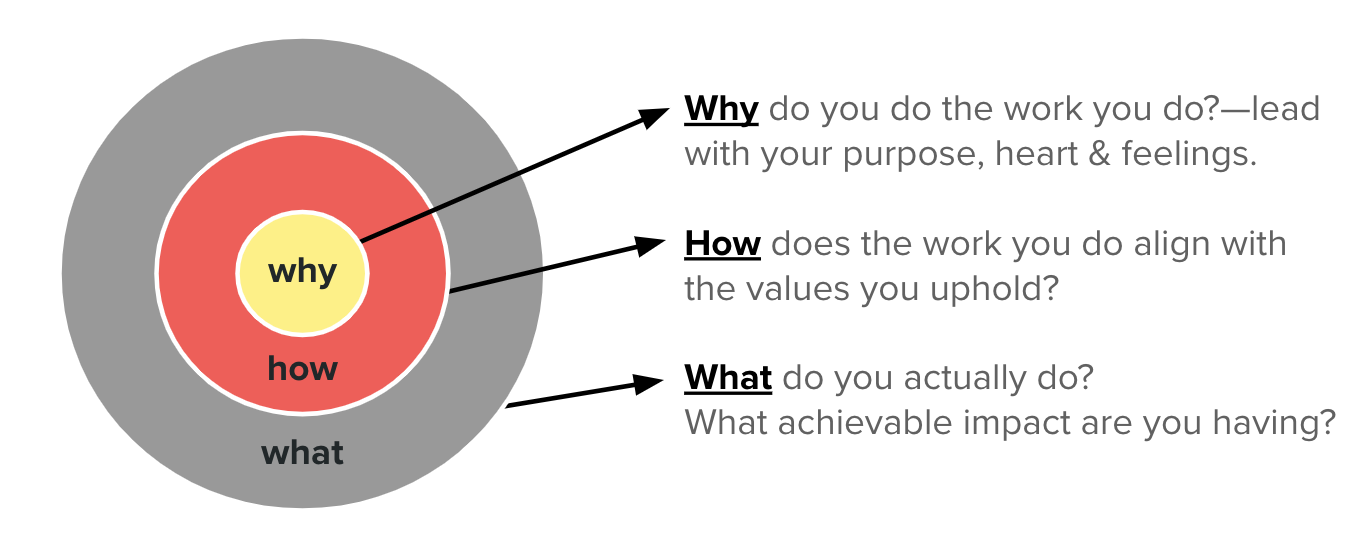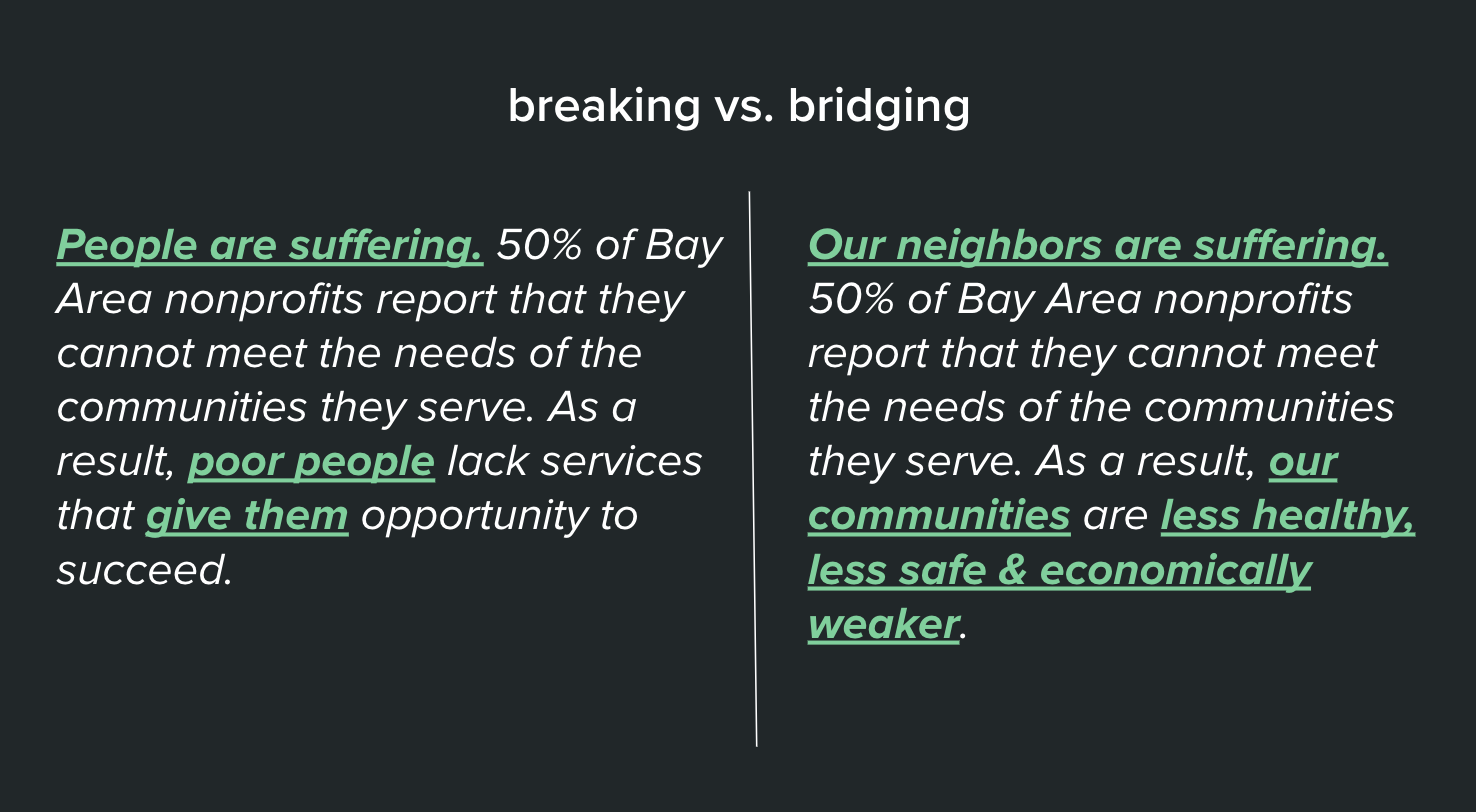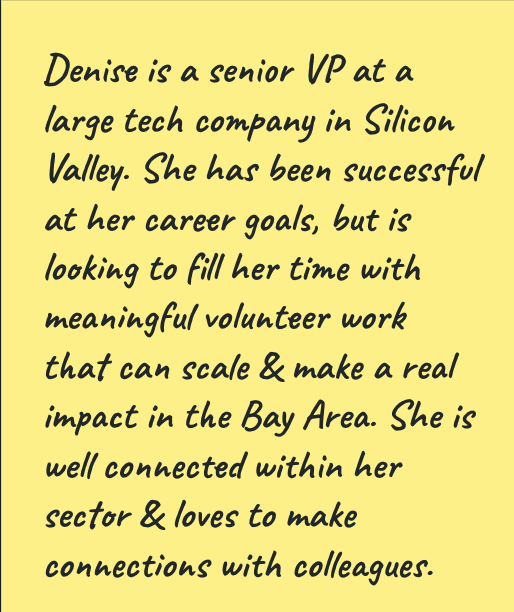Effective nonprofit messaging is critical to nurturing your existing community and growing new relationships.
It can also be hard to communicate the reason that your organization exists and the impact that is has in one crisp statement.
This post will walk you through the basics of creating effective and targeted messaging that can be delivered to a specific target audience and welcome them to be a part of the amazing work you are doing.
Here’s what we will cover:
- Bridging v. Breaking Language
- Know What Motivates Your Audience
- Start With Your “Why”
- Follow With How
- Add in Your Achieveable Impact
- Check Your Work for Diversity, Equity, and Inclusion
- How to Test Your Messaging
What are Impact Communications?
Impact communications help us explain what our organizations have accomplished so far and what we hope to accomplish in the future.
Showing impact
By utilizing data from sources like surveys, databases, and stakeholder interviews, our organizations can prove we’ve made an impact on the problem we’re solving. We communicate this through various forms of storytelling, depending on where an individual is in their engagement journey.
Tip: Early on in the engagement journey, we like to keep messaging concise. As we build a relationship, our supporters may be willing to devote more time to what we have to say, i.e. stories and videos. Of course, there are exceptions to this, based on a persona’s motivations, lifestyle, and interests.
Bridging vs. Breaking Language
The way that we frame our stories and information can have a huge impact on how our communities react. The way we write and talk can either welcome individuals and communities into the work we are doing, or alienate “others” from joining our work.
john a. powell, who leads the Othering & Belonging Institute at U.C. Berkeley, refers to this idea as bridging language vs. breaking language.
Let’s look at the common characteristics of the two:
Breaking Language
- It’s threatening.
- It creates fear of “others” or “them.”
- It promotes the use of falsehoods about “them.”
- It perpetuates isolation and division.
- It hardens existing beliefs.
Bridging Language
It focuses on opportunity.
- It considers a larger “we.”
- It sees diversity as strength.
- It encourages dialogue and listening.
- It removes “them” and encourages “us.”
Bridging language allows us to capture the attention and interest of those we may not otherwise agree with. It establishes a common motivation to solve issues together. Charity Water provides a great example of this:

By using simple statistics, they highlight a universal problem. If you believe everyone should have access to clean water, you’re going to be receptive to this messaging.
Of course, the question you may now be wondering is, how can I build impactful messaging of my own?
Know Your Audience Motivations to Create Effective Messaging
Developing effective messaging is understanding how to frame what you are saying to land well with your target audience. To do this, you need to understand what motivates the audience you are talking to.
To understand motivations, we start by developing personas. Personas are a semi-fictional representation of your ideal constituent. Most importantly, when you are creating personas, you focus on what motivates that persona. Once you have that motivation, it’s easier to create your messaging.
If you haven’t created personas yet, read this post about creating donor personas and engagement journeys.
For the purposes of this post, we’re going to use our example persona from a client of ours, Full Circle Fund. We call this persona the Community Measuring Stick.
Review the Golden Circle
One of the reasons that we seek to understand our personas’ motivations is so that when we develop messaging we can connect our message to what our target persona cares about. We call this their “why.”
As Simon Sinek stated in his now-famous TedTalk:
“People don’t buy what you do, they buy why you do it.”
Meaning that as humans we are biologically wired to use instincts to make decisions. Our “why” are the core instincts that we all have. So, when building your messaging, we want to start with why, then how and then what.
Simon Sinek calls this the “Golden Circle.”

You’ve likely heard the phrase “elevator pitch” tossed around—a common exercise that suggests you only have the length of an elevator ride to convince an ideal funder to support your organization. For most, the idea of crafting a concise, compelling argument can be pretty daunting. Thankfully, the Golden Circle puts forth a formula that parallels our messaging strategy.
Lead with why you do what you do (your purpose) then present your problem statement.
If you don’t present your purpose with a clearly defined threat to that purpose (ie. a problem statement or ‘what’s at risk’), your audience won’t have a reason to care about the work you’re doing. Paint a picture that captures the heart. Why is your organization needed?
Example
Our persona, the Professional Giver, is looking for more than cutting a donation check. She wants to feel a sense of purpose—be hands-on with vetted projects that scale and have meaningful impact. Let’s say she is presented with a problem statement like this:
“Our community members are suffering. 50% of Bay Area nonprofits report that they cannot meet the needs of the communities they serve. As a result, poor communities lack services that give them the opportunity to succeed.”
Why might the Professional Giver like this?
- It presents a large-scale community problem that could lead to large scale change.
- Statistical information shows the sophistication of your organization and leadership.
- It’s a clear and concise hook that summarizes the existing problem.
Before you continue… do an “Equity Pause” and check for breaking language.
As is, our example above is an ‘okay’ messaging statement, but let’s take a second to look at it through the lens of equity and inclusion. Are we using bridging language or breaking language?

Breaking language:
- “People are suffering” – although it isn’t terrible, it feels disconnected, abstract and could lead to implicit assumptions about what type of people are suffering.
- “poor people” – This economically shames people, separating “us” from “them.”
- “give them” – This implies a harmful power dynamic—who is in the position of giving and why are they ‘positioned’ to do so?
Bridging language:
- “our communities” – This shows everyone is affected by these issues.
- “less healthy, less safe, and economically weaker” – This indicates objective outcomes of the problem. It also reemphasizes that everyone is affected and we if we work together we can solve these issues.
Follow with how you’re doing it (your values/solution statement).
This is the response to your problem statement. It shows how you and your organization are uniquely qualified to resolve the problem.
Example
As we continue our example, remember what the Professional Giver cares about. She wants values alignment and in this case that is hands-on change where her skills and experience being used in creating it. She wants to see scale and, because she has limited time, wants to work with vetted projects toward meaningful impact. A solution statement from Full Circle Fund (FCF) could be something like:
“FCF unlocks resources for Bay Area nonprofits by leveraging our members’ business acumen in hands-on experiences to solve challenges that will accelerate nonprofit impact. By facilitating meaningful, cross-sector relationships, FCF is changing the way philanthropy impacts our communities.”
Why might the Professional Giver like this?
- “leading Bay Area nonprofits” – This suggests vetted nonprofit projects.
- “hands-on” – This taps into her desire to utilize her skills and experience as an integral part of the outcome.
- “changing the way philanthropy impacts our communities” – This refers to meaningful impact on the sector as a whole, as well as on her community.
When we combine our purpose, problem and solution statements, they form a solid elevator pitch:
“Our community members are suffering. 50% of Bay Area nonprofits report that they cannot meet the needs of the communities they serve. As a result, our communities are less healthy, less safe and economically weaker compared to other metropolitan areas.
FCF unlocks resources for leading Bay Area nonprofits by leveraging our members’ business acumen through hands-on experiences to solve challenges that will accelerate nonprofit impact. By facilitating meaningful, cross-sector relationships, FCF is changing the way philanthropy impacts our communities.”
You can also see how this type of messaging might fit into a letter, an email, a webpage, or even a series of social media posts.
Finish with what is happening as a result (communicate achieveable impact).
Impact supports your problem and solution statements with data that shows your track record of success. This is proof that what you’re doing is working. It also indicates how your organization is positioned to impact the problem going forward.
By leading with gut feelings (the “why”) and finishing with data (the “what”), you create a solid argument for why people should get engaged with your work.
Example
Let’s pretend FCF conducts a post-engagement survey with all of the partners who go through their programs. In this fictitious survey, 98% of them report their programs have the capacity to serve more clients after working with FCF. We can leverage that information in our messaging to capture our Professional Giver’s attention:
“Our community members are suffering. 50% of Bay Area nonprofits report that they cannot meet the needs of the communities they serve. As a result, our communities are less healthy, less safe and economically weaker compared to other metropolitan areas.
FCF unlocks resources for leading Bay Area nonprofits by leveraging our members’ business acumen through hands-on experiences to solve challenges that will accelerate nonprofit impact. By facilitating meaningful, cross-sector relationships FCF is changing the way philanthropy impacts our communities. 98% of nonprofit partners report that after working with FCF members, their programs are more effective and they have the capacity to serve more clients.”
The added data proves FCF is a viable, sophisticated organization that is worth investing time and money in. Their achieved impact speaks for itself!
Check Your Work for Diversity, Equity, & Inclusion
The language that we use to present stories and messaging is critical to how we frame the challenges of our generation. Is change a threat or an opportunity? Using bridging language versus breaking language can change the dynamic around how we build coalitions of change. Reread your work with that in mind.
Test Your Messaging
If you don’t have a measurement and evaluation program in place, be sure to read “Creating Donor Personas Using Stakeholder Interviews & Surveys”. You might also want to check out “Tips for Conducting Stakeholder Interviews”. In addition to a more in-depth discussion of the process, we’ve got over 100 sample questions and a sample donor survey to get you started.
Keep Going
Impact communications are just one building block in your marketing and communications work. Join our 5-week communications coaching program to elevate your impact and invest in your skills as a nonprofit leader!


